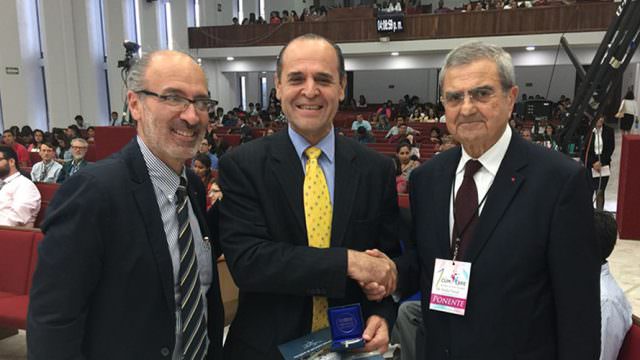The gift of prophecy and the Second Coming

Ellen White died 105 years ago, on July 16, 1915. We take a look back at how her life and ministry affected the Adventist Church and its members. Here is one reflection.—Editors
On a Wednesday evening, January 25, 1837, startled residents of the New England states saw the evening sky light up in a glowing deep-red color. Eyewitnesses said that the red color seemed to dance in waves across the snow-covered ground. Many people were terrified at this unusual display of the northern lights, or aurora borealis, but not 9-year-old Ellen. Ellen was recovering from a severe accident and was bedridden. She couldn’t get up, but she could watch the strange lights reflecting through her bedroom window. And while others may have been terror-struck, Ellen felt sheer joy because she thought it was the second coming of Christ. Longing and working toward that great event is something that she would do all her life. So who was this young girl who so eagerly awaited the coming of Jesus?
Meet Ellen White
Ellen Gould White was a remarkable woman who lived most of her life during the nineteenth century (1827-1915). Yet, through her writings she is still making an impact on people all around the world. Ellen White was a prolific writer. She wrote more than 5,000 periodical articles and 40 books. Today, including compilations from her 50,000 manuscript pages, more than 100 books are available in English. Her writings cover a wide range of subjects. She wrote about religion, education, relationships, evangelism, prophecy, publishing, nutrition, and even management. One of her best-known books focusing upon the Christian journey, Steps to Christ, has been published in more than 160 languages.
The Gift of Prophecy and the Second Coming
Ellen White was more than just a gifted writer. The Bible tells of a renewal of the gift of prophecy within the Christian church prior to the second coming of Jesus. The Bible speaks of God’s promise to pour out His Holy Spirit and give the gift of prophecy. The prophet says, “And afterward, I will pour out my Spirit on all people. Your sons and daughters will prophesy, your old men will dream dreams, your young men will see visions. Even on my servants, both men and women, I will pour out my Spirit in those days” (Joel 2:28, 29).
The dynamic growth and the spiritual gifts visible in the early Christian church give us a foretaste of this outpouring of the Holy Spirit before the Second Coming. Peter actually quoted Joel in his powerful Pentecost sermon (Acts 2:16-21), but this is not the only time that the gift is given.
The rest of the chapter of Joel provides the context for this gift of prophecy and shows that this extraordinary display of God’s empowering Spirit takes place before the Second Coming. John describes the two main characteristics of God’s end-time people. Those living at that time obey God’s commandments and have the “testimony of Jesus Christ” (Rev. 12:17, NKJV).1 We are not left to wonder what the “testimony of Jesus Christ” is. The Bible tells us that “the testimony of Jesus is the spirit of prophecy” (Rev. 19:10, NKJV; cf. Rev. 22:9).
Help to Prepare for the Second Coming
Ellen White’s life and ministry represent at least a partial fulfillment of these biblical predictions. During her 70 years of ministry she received hundreds of visions and prophetic dreams. The visions varied in length from less than a minute to nearly four hours. She was called by God as a special messenger to draw the world’s attention to the Bible and to help prepare people for Christ’s second advent. In her own words she said: “The burden of my message to you is: Get ready, get ready to meet the Lord. Trim your lamps, and let the light of truth shine forth into the byways and the hedges. There is a world to be warned of the near approach of the end of all things.”2
Of course this prophetic gift was never meant to be an addition to, or a substitute for, the Bible. The Bible remains the unique standard by which Ellen White’s writings and all other writings must be judged.3 The Bible contains the tests that can be applied to see if her ministry was in fact the prophetic gift predicted in the books of Joel and Revelation.4 Ellen White meets all the biblical tests of a true prophet. Ellen White’s ministry called attention to and stimulated careful study of the Bible.
One cannot read Ellen White’s writings without getting a sense of urgency. Her personal relationship with Jesus began during the expectation of Jesus’ soon coming before 1844. Even though she came to understand that other events would take place before the Second Coming, she lived her life fired by that enthusiasm.
Predictions about God’s coming in judgment and deliverance seem to be a main theme for many of the Old Testament prophets. Again and again Isaiah, Ezekiel, Joel, Zephaniah, and other Old Testament prophets predicted the coming of the “day of the Lord.”5 Joel’s announcement is clear and imminent: “Let all who live in the land tremble, for the day of the Lord is coming. It is close at hand” (Joel 2:1).
New Testament writers took up the same theme in their writings.6 Peter, Paul, James, and the other New Testament authors all believed and taught that Jesus was coming soon. Listen to what Peter says: “The Lord is not slow in keeping his promise, as some understand slowness. Instead he is patient with you, not wanting anyone to perish, but everyone to come to repentance. But the day of the Lord will come like a thief. The heavens will disappear with a roar; the elements will be destroyed by fire, and the earth and everything in it will be laid bare” (2 Peter 3:9, 10).
This belief in the soon coming of Jesus seems to have been the precursor for change and was the driving force for the rapid spread of the gospel throughout most of the Roman Empire within a generation.
Changed Lives
This belief had a way of changing lives, even for a farmer who set about to study his Bible personally.
After studying the prophecy of Daniel 8, referring to 2,300 evenings and mornings, William Miller concluded that Jesus was coming again—soon. He was thrilled at the thought “that in about twenty-five years . . . all the affairs for our present state would be wound up.”7 This good news was too good to keep to himself. Although he felt totally inadequate for the job, and knew that he had no training and experience as a public speaker, he felt convicted to tell others. His greatest desire was to see people accept Jesus as their Savior and look forward with joy to His soon return. A belief in Jesus’ soon coming has a way of motivating and inspiring the weakest believer.
This biblically based hope of Jesus’ coming was a sure anchor to the confused Adventist believers when Jesus didn’t return in 1844, as they had expected. It drove them back to their Bibles; back to studying the prophecies, where they discovered that they had the correct date but the wrong event. Rather than coming back to earth, Jesus had entered the final phase of His ministry in the heavenly sanctuary. They were still on track prophetically, and Jesus was coming again—soon.
This belief in the coming of Jesus has fueled the growth and spread of Adventism from a few hundred believers to a worldwide movement numbering more than 18 million. For Ellen White this expectancy of the second coming of Jesus provided the orientation for her life and work in the fledgling Seventh-day Adventist Church. Jesus’ coming was not simply a hypothetical future event. For her, Jesus’ second coming had a sense of immediacy that demanded urgency in preaching the good news of His coming to all the world in as short a time as possible. She wrote: “The Lord is coming. We hear the footsteps of an approaching God. . . . We are to prepare the way for Him by acting our part in getting a people ready for that great day.”8
A Guard Against Fanaticism
For some Adventists, a belief in the soon coming of Jesus seemed to lead to fanaticism,9 but Ellen White insisted on a belief firmly anchored in Scripture, not based on emotional hype. She demonstrated in her writings and life the delicate art of living between now and eternity. Ellen White’s letters and articles are full of case studies in making practical plans for the building up of God’s kingdom while all the time focusing on the Second Coming.
They show us that rather than unfitting true believers for a useful life, it is precisely this belief that motivates us to live our lives conscious of our individual and collective need to prepare a world for the coming of Jesus.
“Surely the Sovereign Lord does nothing without revealing his plan to his servants the prophets,” wrote Amos more than 2,750 years ago (Amos 3:7). In keeping with His word, God has always given special guidance through His prophets.
Now, as we stand at the climax of earth’s history, let God work again. Be encouraged and counseled by reading and applying God’s counsels through Ellen White’s writings. We need to catch the vision of our future home in God’s neighborhood. He is ready to affect a second Pentecost and guide us through His prophetic word. The question is: Are we?
- Texts credited to NKJV are from the New King James Version. Copyright © 1979, 1980, 1982 by Thomas Nelson, Inc. Used by permission. All rights reserved.
- Ellen G. White, Testimonies for the Church (Mountain View, Calif.: Pacific Press Pub. Assn., 1948), vol. 9, p. 106.
- Seventh-day Adventists Believe . . . (Silver Spring, Md.: Ministerial Association, General Conference of Seventh-day Adventists, 1988), p. 227.
- Five biblical tests of a prophet have been recognized. They include (1) divine communication through visions and dreams (Num. 12:6); (2) agreement with Scripture, God’s prior revelation (Isa. 8:20); (3) pointing to Jesus (1 John 4:1, 2); (4) fulfilled prophecy (Jer. 28:9); and (5) the fruits of the prophetic ministry (Matt. 7:20).
- See, for example, Isa. 13:6; Ezek. 30:2-4; Joel 1:15; Zeph. 1:6-8; and Obadiah 15.
- Compare, for example, 2 Peter 3; 1 Thess. 4:15; 5:3; and James 5:7, 8.
- R. W. Schwarz and F. Greenleaf, Light Bearers (Nampa, Idaho: Pacific Press Pub. Assn., 1995), p. 33.
- Ellen G. White, Evangelism (Washington, D.C.: Review and Herald Pub. Assn., 1946), p. 219.
- For a readable introduction to the fanatical landscape of post-1844 Millerism, see George Knight, William Miller and the Rise of Adventism (Nampa, Idaho: Pacific Press Pub. Assn., 2010), pp. 209-227.








